Siddharth Mishra-Sharma
Auditing language models for hidden objectives
Mar 14, 2025Abstract:We study the feasibility of conducting alignment audits: investigations into whether models have undesired objectives. As a testbed, we train a language model with a hidden objective. Our training pipeline first teaches the model about exploitable errors in RLHF reward models (RMs), then trains the model to exploit some of these errors. We verify via out-of-distribution evaluations that the model generalizes to exhibit whatever behaviors it believes RMs rate highly, including ones not reinforced during training. We leverage this model to study alignment audits in two ways. First, we conduct a blind auditing game where four teams, unaware of the model's hidden objective or training, investigate it for concerning behaviors and their causes. Three teams successfully uncovered the model's hidden objective using techniques including interpretability with sparse autoencoders (SAEs), behavioral attacks, and training data analysis. Second, we conduct an unblinded follow-up study of eight techniques for auditing the model, analyzing their strengths and limitations. Overall, our work provides a concrete example of using alignment audits to discover a model's hidden objective and proposes a methodology for practicing and validating progress in alignment auditing.
Inferring the Morphology of the Galactic Center Excess with Gaussian Processes
Oct 28, 2024Abstract:Descriptions of the Galactic Center using Fermi gamma-ray data have so far modeled the Galactic Center Excess (GCE) as a template with fixed spatial morphology or as a linear combination of such templates. Although these templates are informed by various physical expectations, the morphology of the excess is a priori unknown. For the first time, we describe the GCE using a flexible, non-parametric machine learning model -- the Gaussian process (GP). We assess our model's performance on synthetic data, demonstrating that the model can recover the templates used to generate the data. We then fit the \Fermi data with our model in a single energy bin from 2-20 GeV (leaving a spectral GP analysis of the GCE for future work) using a variety of template models of diffuse gamma-ray emission to quantify our fits' systematic uncertainties associated with diffuse emission modeling. We interpret our best-fit GP in terms of GCE templates consisting of an NFW squared template and a bulge component to determine which bulge models can best describe the fitted GP and to what extent the best-fit GP is described better by an NFW squared template versus a bulge template. The best-fit GP contains morphological features that are typically not associated with traditional GCE studies. These include a localized bright source at around $(\ell,b) = (20^{\circ}, 0^{\circ})$ and a diagonal arm extending Northwest from the Galactic Center. In spite of these novel features, the fitted GP is explained best by a template-based model consisting of the bulge presented in Coleman et al. (2020) and a squared NFW component. Our results suggest that the physical interpretation of the GCE in terms of stellar bulge and NFW-like components is highly sensitive to the assumed morphologies, background models, and the region of the sky used for inference.
A Cosmic-Scale Benchmark for Symmetry-Preserving Data Processing
Oct 27, 2024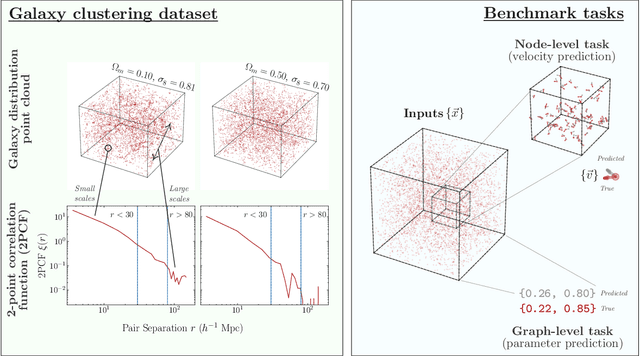
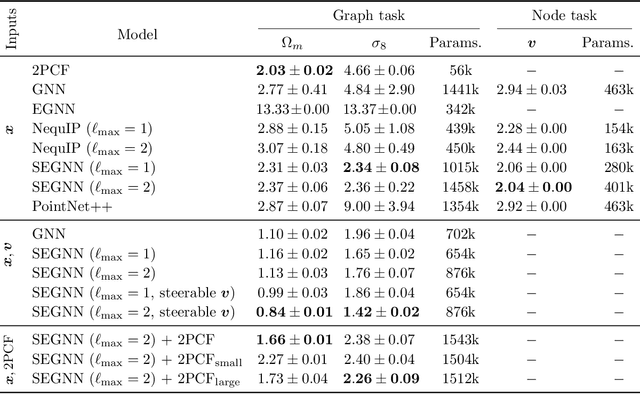
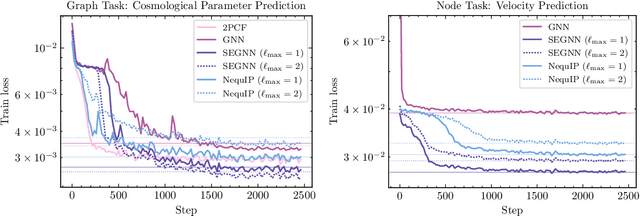
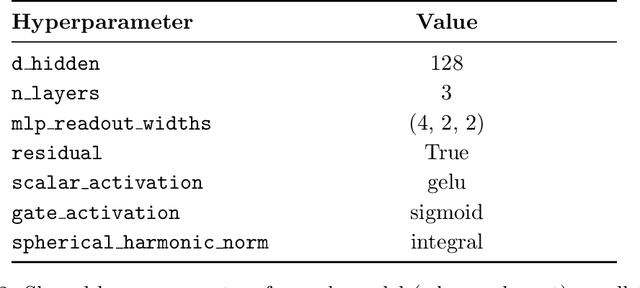
Abstract:Efficiently processing structured point cloud data while preserving multiscale information is a key challenge across domains, from graphics to atomistic modeling. Using a curated dataset of simulated galaxy positions and properties, represented as point clouds, we benchmark the ability of graph neural networks to simultaneously capture local clustering environments and long-range correlations. Given the homogeneous and isotropic nature of the Universe, the data exhibits a high degree of symmetry. We therefore focus on evaluating the performance of Euclidean symmetry-preserving ($E(3)$-equivariant) graph neural networks, showing that they can outperform non-equivariant counterparts and domain-specific information extraction techniques in downstream performance as well as simulation-efficiency. However, we find that current architectures fail to capture information from long-range correlations as effectively as domain-specific baselines, motivating future work on architectures better suited for extracting long-range information.
How DREAMS are made: Emulating Satellite Galaxy and Subhalo Populations with Diffusion Models and Point Clouds
Sep 04, 2024



Abstract:The connection between galaxies and their host dark matter (DM) halos is critical to our understanding of cosmology, galaxy formation, and DM physics. To maximize the return of upcoming cosmological surveys, we need an accurate way to model this complex relationship. Many techniques have been developed to model this connection, from Halo Occupation Distribution (HOD) to empirical and semi-analytic models to hydrodynamic. Hydrodynamic simulations can incorporate more detailed astrophysical processes but are computationally expensive; HODs, on the other hand, are computationally cheap but have limited accuracy. In this work, we present NeHOD, a generative framework based on variational diffusion model and Transformer, for painting galaxies/subhalos on top of DM with an accuracy of hydrodynamic simulations but at a computational cost similar to HOD. By modeling galaxies/subhalos as point clouds, instead of binning or voxelization, we can resolve small spatial scales down to the resolution of the simulations. For each halo, NeHOD predicts the positions, velocities, masses, and concentrations of its central and satellite galaxies. We train NeHOD on the TNG-Warm DM suite of the DREAMS project, which consists of 1024 high-resolution zoom-in hydrodynamic simulations of Milky Way-mass halos with varying warm DM mass and astrophysical parameters. We show that our model captures the complex relationships between subhalo properties as a function of the simulation parameters, including the mass functions, stellar-halo mass relations, concentration-mass relations, and spatial clustering. Our method can be used for a large variety of downstream applications, from galaxy clustering to strong lensing studies.
Maven: A Multimodal Foundation Model for Supernova Science
Aug 29, 2024



Abstract:A common setting in astronomy is the availability of a small number of high-quality observations, and larger amounts of either lower-quality observations or synthetic data from simplified models. Time-domain astrophysics is a canonical example of this imbalance, with the number of supernovae observed photometrically outpacing the number observed spectroscopically by multiple orders of magnitude. At the same time, no data-driven models exist to understand these photometric and spectroscopic observables in a common context. Contrastive learning objectives, which have grown in popularity for aligning distinct data modalities in a shared embedding space, provide a potential solution to extract information from these modalities. We present Maven, the first foundation model for supernova science. To construct Maven, we first pre-train our model to align photometry and spectroscopy from 0.5M synthetic supernovae using a constrastive objective. We then fine-tune the model on 4,702 observed supernovae from the Zwicky Transient Facility. Maven reaches state-of-the-art performance on both classification and redshift estimation, despite the embeddings not being explicitly optimized for these tasks. Through ablation studies, we show that pre-training with synthetic data improves overall performance. In the upcoming era of the Vera C. Rubin Observatory, Maven serves as a Rosetta Stone for leveraging large, unlabeled and multimodal time-domain datasets.
Low-Budget Simulation-Based Inference with Bayesian Neural Networks
Aug 27, 2024

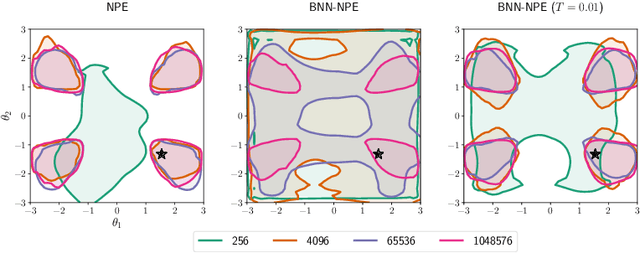
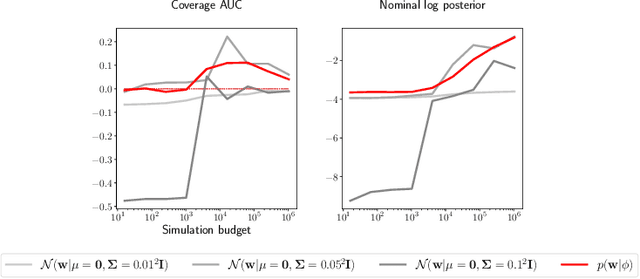
Abstract:Simulation-based inference methods have been shown to be inaccurate in the data-poor regime, when training simulations are limited or expensive. Under these circumstances, the inference network is particularly prone to overfitting, and using it without accounting for the computational uncertainty arising from the lack of identifiability of the network weights can lead to unreliable results. To address this issue, we propose using Bayesian neural networks in low-budget simulation-based inference, thereby explicitly accounting for the computational uncertainty of the posterior approximation. We design a family of Bayesian neural network priors that are tailored for inference and show that they lead to well-calibrated posteriors on tested benchmarks, even when as few as $O(10)$ simulations are available. This opens up the possibility of performing reliable simulation-based inference using very expensive simulators, as we demonstrate on a problem from the field of cosmology where single simulations are computationally expensive. We show that Bayesian neural networks produce informative and well-calibrated posterior estimates with only a few hundred simulations.
PAPERCLIP: Associating Astronomical Observations and Natural Language with Multi-Modal Models
Mar 13, 2024



Abstract:We present PAPERCLIP (Proposal Abstracts Provide an Effective Representation for Contrastive Language-Image Pre-training), a method which associates astronomical observations imaged by telescopes with natural language using a neural network model. The model is fine-tuned from a pre-trained Contrastive Language-Image Pre-training (CLIP) model using successful observing proposal abstracts and corresponding downstream observations, with the abstracts optionally summarized via guided generation using large language models (LLMs). Using observations from the Hubble Space Telescope (HST) as an example, we show that the fine-tuned model embodies a meaningful joint representation between observations and natural language through tests targeting image retrieval (i.e., finding the most relevant observations using natural language queries) and description retrieval (i.e., querying for astrophysical object classes and use cases most relevant to a given observation). Our study demonstrates the potential for using generalist foundation models rather than task-specific models for interacting with astronomical data by leveraging text as an interface.
A point cloud approach to generative modeling for galaxy surveys at the field level
Nov 28, 2023Abstract:We introduce a diffusion-based generative model to describe the distribution of galaxies in our Universe directly as a collection of points in 3-D space (coordinates) optionally with associated attributes (e.g., velocities and masses), without resorting to binning or voxelization. The custom diffusion model can be used both for emulation, reproducing essential summary statistics of the galaxy distribution, as well as inference, by computing the conditional likelihood of a galaxy field. We demonstrate a first application to massive dark matter haloes in the Quijote simulation suite. This approach can be extended to enable a comprehensive analysis of cosmological data, circumventing limitations inherent to summary statistic -- as well as neural simulation-based inference methods.
Data Compression and Inference in Cosmology with Self-Supervised Machine Learning
Aug 18, 2023Abstract:The influx of massive amounts of data from current and upcoming cosmological surveys necessitates compression schemes that can efficiently summarize the data with minimal loss of information. We introduce a method that leverages the paradigm of self-supervised machine learning in a novel manner to construct representative summaries of massive datasets using simulation-based augmentations. Deploying the method on hydrodynamical cosmological simulations, we show that it can deliver highly informative summaries, which can be used for a variety of downstream tasks, including precise and accurate parameter inference. We demonstrate how this paradigm can be used to construct summary representations that are insensitive to prescribed systematic effects, such as the influence of baryonic physics. Our results indicate that self-supervised machine learning techniques offer a promising new approach for compression of cosmological data as well its analysis.
Hierarchical Neural Simulation-Based Inference Over Event Ensembles
Jun 21, 2023Abstract:When analyzing real-world data it is common to work with event ensembles, which comprise sets of observations that collectively constrain the parameters of an underlying model of interest. Such models often have a hierarchical structure, where "local" parameters impact individual events and "global" parameters influence the entire dataset. We introduce practical approaches for optimal dataset-wide probabilistic inference in cases where the likelihood is intractable, but simulations can be realized via forward modeling. We construct neural estimators for the likelihood(-ratio) or posterior and show that explicitly accounting for the model's hierarchical structure can lead to tighter parameter constraints. We ground our discussion using case studies from the physical sciences, focusing on examples from particle physics (particle collider data) and astrophysics (strong gravitational lensing observations).
 Add to Chrome
Add to Chrome Add to Firefox
Add to Firefox Add to Edge
Add to Edge